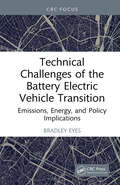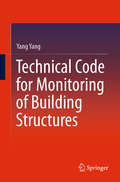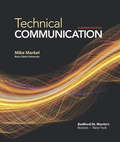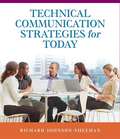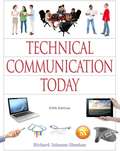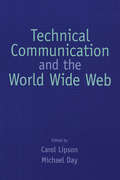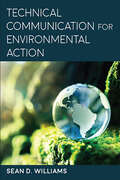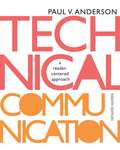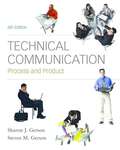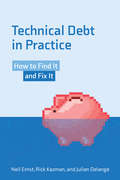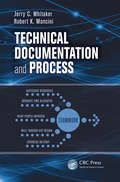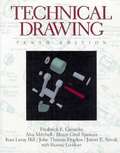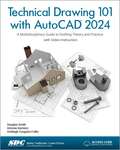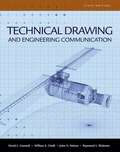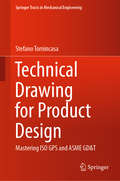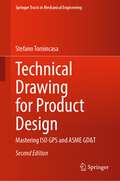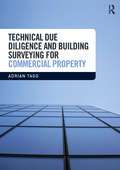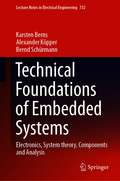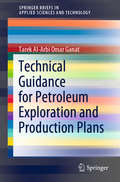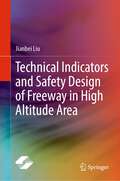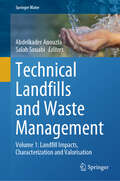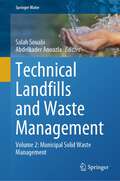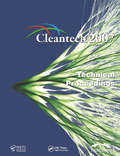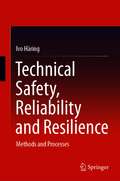- Table View
- List View
Technical Challenges of the Battery Electric Vehicle Transition: Emissions, Energy, and Policy Implications
by Bradley EyesThis practical guide identifies the technical challenges of transitioning to battery electric vehicles in Australia, reviews the impacts of life cycle emissions on passenger transport systems, and presents government, institutional and personal requirements for reducing passenger vehicle mode share.Accommodating renewable energy sources to achieve emission reductions following a 1.5°C pathway laid out by the Intergovernmental Panel on Climate Change (IPCC) will require a significant reduction in transport energy demand. This book guides the reader through multiple necessary approaches, including demand reduction, significant holistic efficiency increases, and technology adoption that progresses beyond physical transport options. The scope is for the medium to long-term, addressing the complex challenges of battery electric vehicle sales regulation and disposal to 2050. Successful examples and policies from around the world are reviewed to showcase necessary societal changes to support a transition to sustainable transport in cities. The book provides readers with a fundamental technical understanding of passenger transport energy demand and necessary emissions reduction solutions. Applying this knowledge is fundamental in decision-making for sustainable transport solutions.This accessible and practical shortform book provides information necessary for policy-makers, transport industry professionals, and interested sustainability researchers. Although the discussion and focus are on Australian cities, the cases described, policies analyzed, and recommendations made are applicable to any developed city worldwide.
Technical Code for Monitoring of Building Structures
by Yang YangThis book is used as a reference book for researcher and engineer of the world to learn the building monitoring standard of China for the first time, and is also be used as a reference manual for engineer to engage in practical monitoring projects. The standard for project construction of “Technical Code for Monitoring of Building Structures in Qinghai Province” is the first standard for building structure monitoring engineering in China, which integrates design, construction and acceptance of monitoring technique. It can be applied to any place in the world not limited to Qinghai. The standard specifies the warning thresholds for various building structure monitoring parameters. In the monitoring technology, advanced monitoring technologies such as structure group, cloud platform, and BIM are adopted. It has strong operability for monitoring building structures according to the requirement of the standard, provides technical support for ensuring the safety of building structure, and fills in the blank of building structure safety monitoring technology in high and cold high-altitude areas. It contains specific measures to implement housing security for the first time, which is one of the “two without worries and three guarantees” proposed by General Secretary Xi Jinping. It is also used as a reference book for senior undergraduate and graduate students in colleges and universities.
Technical Communication
by Mike MarkelInstructors know that Mike Markel's Technical Communication will prepare their students for any workplace writing situation. No other text offers such a comprehensive introduction to the field while still delivering practical, effective support for students at every level. The eleventh edition has been thoroughly revised to reframe the work of technical communicators in the context of today's highly collaborative, rapidly evolving digital practices. Fresh, social-media driven sample documents and coverage of the latest tools and technologies ensure that students work with the kinds of processes and products they'll encounter on the job.
Technical Communication Strategies for Today
by Richard Johnson-SheehanTechnical Communication Strategies for Today offers students all of the topics and genres they need for their technical communication course. Students want their textbooks to cost less, and they want comprehensive topical coverage presented in a succinct and clear writing style. Technical Communication Strategies for Today offers both and speaks to today's students. Instructional narrative is "chunked," so that portions of text are combined with graphics. The chunked presentation also integrates an awareness of how documents are read-often skimmed by readers seeking the information they need, and it models the way today's technical documents should be designed. The contemporary writing style is matched by an approach that accurately reflects the modern day computer-centered technical workplace: Technical Communication Strategies for Today presents computers as thinking tools that powerfully influence how we develop, produce, design, and deliver technical documents and presentations.
Technical Communication Today (Fifth Edition)
by Richard Johnson-SheehanTechnical Communication Today was written for introduction to technical communication or technical writing courses taught most often in English Departments. Technical Communication Today remains the only text to fully centralize the computer in the technical workplace, presenting how writers use computers throughout their communication process. Writers use their computers to help them think, research, compose, design, and edit. Not only is Technical Communication Today firmly rooted in core rhetorical principles, but the text also presents computers as thinking tools that powerfully influence how we develop, produce, design, and deliver technical documents and presentations. Technical Communication Today speaks to today's students and how they expect to learn information. Instructional narrative is "chunked," so that readable portions of text are combined with graphics. This presentation facilitate learning, and models the way today's technical documents should be designed. Additionally, the chunked presentation integrates an awareness of how documents are read--often "raided" by readers seeking the information they need. By mirroring these processes in its content and structure, Technical Communication Today offers readers a higher level of accessibility.
Technical Communication and the World Wide Web
by Michael Day Carol LipsonOver the past decade, the World Wide Web has dramatically changed the face of technical communication, but the teaching of writing has thus far altered very little to accommodate this rapidly changing context. Technical Communication and the World Wide Web offers substantial and broadly applicable strategies for teaching global communication issues affecting writing for the World Wide Web.Editors Carol Lipson and Michael Day have brought together an exceptional group of experienced and well-known teacher-scholars to develop this unique volume addressing technical communication education. The chapters here focus specifically on curriculum issues and the teaching of technical writing for the World Wide Web, contributing a blend of theory and practice in proposing changes in curriculum and pedagogy. Contributors offer classroom examples that teachers at all levels of experience can adapt for their own classes. The volume provides comprehensive coverage of the technical communication curriculum, from the two-year level to the graduate level; from service courses to degree programs.This volume is an important and indispensable resource for technical writing educators, and it will serve as an essential reference for curriculum and pedagogy development in technical communication programs.
Technical Communication for Environmental Action (SUNY series, Studies in Technical Communication)
by Sean D. WilliamsClimate change is one of the most significant challenges facing the global community in the twenty-first century. With its position at the border of people, technology, science, and communication, technical communication has a significant role to play in helping to solve these complex environmental problems. This collection of essays engages scholars and practitioners in a conversation about how the field has contributed to pragmatic and democratic action to address climate change. Compared to most prior work—which offers theoretical perspectives of environmental communication—this collection explores the actual practice of international technical communicators who participate in government projects, corporate processes, nonprofit programs, and international agency work, demonstrating how technical communication theories such as participatory design, social justice, and ethics can help shape pragmatic environmental action.br>SUNY Press has collaborated with Knowledge Unlatched to unlock KU Focus Collection titles. The Knowledge Unlatched titles have been made open access through libraries coming together to crowd fund the publication cost. Each monograph has been released as open access making the eBook freely available to readers worldwide. Discover more about the Knowledge Unlatched program here: https://www.knowledgeunlatched.org/. It can also be found in the SUNY Open Access Repository at <a href="https://soar.suny.edu/handle/20.500.12648/8482 ">https://soar.suny.edu/handle/20.500.12648/8482 .
Technical Communication: A Reader-Centered Approach (Eigthth Edition)
by Paul V. AndersonThe book intends to improve the students' writing and design skills.Also includes new learning outcomes at the start of each chapter to help students gain more from their reading.
Technical Communication: Process and Product (6th edition)
by Sharon J. Gerson Steven M. GersonThis 6th edition of Technical Communication: Process and Product guides readers through the entire writing process -- pre-writing, writing, and rewriting -- developing an easy-to-use, step-by-step technique for writing the types of documents they will encounter on the job.
Technical Debt in Practice: How to Find It and Fix It
by Rick Kazman Neil Ernst Julien DelangeThe practical implications of technical debt for the entire software lifecycle; with examples and case studies.Technical debt in software is incurred when developers take shortcuts and make ill-advised technical decisions in the initial phases of a project, only to be confronted with the need for costly and labor-intensive workarounds later. This book offers advice on how to avoid technical debt, how to locate its sources, and how to remove it. It focuses on the practical implications of technical debt for the entire software life cycle, with examples and case studies from companies that range from Boeing to Twitter. Technical debt is normal; it is part of most iterative development processes. But if debt is ignored, over time it may become unmanageably complex, requiring developers to spend all of their effort fixing bugs, with no time to add new features--and after all, new features are what customers really value. The authors explain how to monitor technical debt, how to measure it, and how and when to pay it down. Broadening the conventional definition of technical debt, they cover requirements debt, implementation debt, testing debt, architecture debt, documentation debt, deployment debt, and social debt. They intersperse technical discussions with "Voice of the Practitioner" sidebars that detail real-world experiences with a variety of technical debt issues.
Technical Documentation and Process
by Jerry C. Whitaker Robert K. ManciniWe live in an age of electronic interconnectivity, with co-workers across the hall and across the ocean, and managing meetings can be a challenge across multiple time zones and cultures. This makes documenting your projects more important than ever. In Technical Documentation and Process, Jerry Whitaker and Bob Mancini provide the background and structure to help you document your projects more effectively. With more than 60 years of combined experience in successfully documenting complex engineering projects, the authors guide you in developing appropriate process and documentation tools that address the particular needs of your organization. Features Strategies for documenting a project, product, or facility A sample style guide template—the foundation on which you can build documents of various types A selection of document templates Ideas for managing complex processes and improving competitiveness using systems engineering and concurrent engineering practices Basic writing standards and helpful references Major considerations for disaster planning Discussion of standardization to show how it can help reduce costs Helpful tips to manage remote meetings and other communications First-hand examples from the authors’ own experience Throughout, the authors offer practical guidelines, suggestions, and lessons that can be applied across a wide variety of project types and organizational structures. Comprehensive yet to the point, this book helps you define the process, document the plan, and manage your projects more confidently.
Technical Drawing (Tenth Edition)
by Henry Cecil Spencer John Thomas Dygdon James E. Novak Frederick E. Giesecke Alva Mitchell Ivan Leroy Hill Shawna LockhartThe Tenth Edition has been redesigned to appeal to today's visually oriented readers, but retains the practical step-by-step explanations of procedures and excellent problems that has made this book so successful in past editions.
Technical Drawing 101 with AutoCAD 2024: A Multidisciplinary Guide to Drafting Theory and Practice with Video Instruction
by Douglas Smith Ashleigh Congdon-Fuller Antonio RamirezTechnical Drawing 101 covers topics ranging from the most basic, such as making freehand, multiview sketches of machine parts, to the advanced―creating an AutoCAD dimension style containing the style settings defined by the ASME Y14.5-2009 Dimensioning and Tolerancing standard. But unlike the massive technical drawing reference texts on the market, Technical Drawing 101 aims to present just the right mix of information and projects that can be reasonably covered by faculty, and assimilated by students, in one semester. Both mechanical and architectural projects are introduced to capture the interest of more students and to offer a broader appeal.
Technical Drawing and Engineering Communication
by David L. Goetsch John A. Nelson Raymond L. Rickman William S. ChalkDevelop the drawing skills you need for a successful career in CAD, drafting, or design with this comprehensive, widely successful book, now in its 6th edition! Technical Drawing and Engineering Communication, 6E offers readers the "total technical drawing experience," with coverage that spans from basic to advanced aspects of engineering and industrial technology. It provides a fundamental exposure to design and visualization for computer modeling, while still presenting thorough coverage of more traditional methods of technical drawing. With revisions that reflect the very latest information on CAD, GIS, the Internet, ISO 9000, and solid modeling, this book is a valuable resource, with applications to various drafting disciplines.
Technical Drawing for Product Design: Mastering ISO GPS and ASME GD&T (Springer Tracts in Mechanical Engineering)
by Stefano TornincasaThis book is intended for students, academics, designers, process engineers and CMM operators, and presents the ISO GPS and the ASME GD&T rules and concepts. The Geometric Product Specification (GPS) and Geometrical Dimensioning and Tolerancing (GD&T) languages are in fact the most powerful tools available to link the perfect geometrical world of models and drawings to the imperfect world of manufactured parts and assemblies. The topics include a complete description of all the ISO GPS terminology, datum systems, MMR and LMR requirements, inspection, and gauging principles. Moreover, the differences between ISO GPS and the American ASME Y14.5 standards are shown as a guide and reference to help in the interpretation of drawings of the most common dimensioning and tolerancing specifications.The book may be used for engineering courses and for professional grade programmes, and it has been designed to cover the fundamental geometric tolerancing applications as well as the more advanced ones. Academics and professionals alike will find it to be an excellent teaching and research tool, as well as an easy-to-use guide.
Technical Drawing for Product Design: Mastering ISO GPS and ASME GD&T (Springer Tracts in Mechanical Engineering)
by Stefano TornincasaThis book is intended for students, academics, designers, process engineers and CMM operators, and presents the ISO GPS and the ASME GD&T rules and concepts. The Geometric Product Specification (GPS) and Geometrical Dimensioning and Tolerancing (GD&T) languages are in fact the most powerful tools available to link the perfect geometrical world of models and drawings to the imperfect world of manufactured parts and assemblies. The topics include a complete description of all the ISO GPS terminology, datum systems, MMR and LMR requirements, inspection, and gauging principles. Moreover, the differences between ISO GPS and the American ASME Y14.5 standards are shown as a guide and reference to help in the interpretation of drawings of the most common dimensioning and tolerancing specifications. The book may be used for engineering courses and for professional grade programmes, and it has been designed to cover the fundamental geometric tolerancing applications as well as the more advanced ones. Academics and professionals alike will find it to be an excellent teaching and research tool, as well as an easy-to-use guide. This 2nd, revised edition includes several improved features: - It highlights the tools provided in the recently published ISO GPS standards, such as ISO 22081-2021 and ISO 2692-2021. - New concepts and rules in accordance with the latest revision to the GD&T standard, ASME Y14.5.1-2019, Mathematical Definition of Dimensioning and Tolerancing Principles. - Most of the drawings have been redrawn and updated even further to the new standards. - Changes have been made to the text and illustrations to improve readability and clarify the content Additional contents and examples have been included. - The chapters dedicated to profile tolerance and tolerances (ISO 14405) have been extended and rewritten.
Technical Due Diligence and Building Surveying for Commercial Property
by Adrian TaggTechnical Due Diligence and Building Surveying for Commercial Property is the first book to introduce the process of technical due diligence (TDD) and examine the role of the building surveyor within the commercial property sector. The book outlines the processes that the surveyor must go through when performing a TDD inspection and report and, most importantly, covers in detail the typical pathology and defects encountered during TDD. Performing a TDD survey involves collecting, analysing and reporting on a huge amount of information, often under specific contractual conditions. The book covers everything the surveyor needs to know in order to do a proper job and includes analysis of materials, life cycles and potential defects on an elemental basis, with detail on individual components where necessary. Coverage includes: • an introduction to the TDD process and types of commercial buildings encountered • chapters outlining the life cycle and defects of: structures, roofs, facades, finishes and services • hundreds of illustrations and photographs of defects, real-world case studies and suggestions for further reading • a final chapter covering legal issues and technical details. This book fills a clear gap in the literature and is the first fully illustrated book on TDD dedicated to commercial building stock. It will help students and professionals to understand the process, the science involved and the reasons why defects occur, as well as their evolution and long-term impact.
Technical Editing: An Introduction to Editing in the Workplace
by Donald H. Cunningham Edward A. Malone Joyce M. RothschildTechnical Editing: An Introduction to Editing in the Workplace offers the most comprehensive, accessible, and current approach to technical and professional editing. <p><p>Written by an experienced author team, the first part of the text provides an overview of the editing process (appraising the document, creating an editing plan, and implementing the plan), the second part covers substantive editing (editing for organization, completeness, accuracy, etc.), and the third part explains copyediting (from its principles and procedures to their application in practice) and proofreading. <p><p>The authors discuss such topics as fraud in the workplace and whistleblowing; navigation aids in print and digital documents; redaction of classified or confidential information; layout and design principles; controlled languages, the plain English movement, and international varieties of English; content reuse and content management systems; and electronic editing skills. The book provides ample coverage of grammar, punctuation, and usage, with many authentic examples from technical and business documents.
Technical Foundations of Embedded Systems: Electronics, System theory, Components and Analysis (Lecture Notes in Electrical Engineering #732)
by Karsten Berns Alexander Köpper Bernd SchürmannThis textbook offers a comprehensive introduction to the methodological and technical knowledge necessary for the development of embedded systems. At first, the foundations of embedded systems from the fields of electronics, systems theory and control theory are introduced for computer scientists and engineers without extensive knowledge of electrical engineering. Subsequently, system components as well as digital communication between embedded system nodes are discussed. The book ends with procedures for the analysis of embedded systems and for real-time processing. It is aimed at students and users of computer science as well as engineers, physicists and mathematicians who are interested in the basics of developing embedded systems.
Technical Guidance for Petroleum Exploration and Production Plans (SpringerBriefs in Applied Sciences and Technology)
by Tarek Al-Arbi GanatThis book presents detailed explanations of how to formulate field development plans for oil and gas discovery. The data and case studies provided here, obtained from the authors’ field experience in the oil and gas industry around the globe, offer a real-world context for the theories and procedures discussed. The book covers all aspects of field development plan processes, from reserve estimations to economic analyses. It shows readers in both the oil and gas industry and in academia how to prepare field development plans in a straightforward way, and with substantially less uncertainty.
Technical Indicators and Safety Design of Freeway in High Altitude Area
by Jianbei LiuQinghai-Tibet Plateau has many special characteristics, such as low pressure and hypoxia, complex geological conditions, fragile ecological environment, and various bad weather conditions, which exerts a negative effect on highway construction and traffic safety. It is a huge challenge to build a safe and environment-friendly highway on the Tibetan Plateau due to lacking of mature experience around the world. Therefore, this book was supported by the National Science and Technology Support Program: highway construction technology in high altitude and cold regions to research the critical indicators and technologies. This book focuses on the driving behavior and typical vehicle characteristics in the high altitude area to put forward a series of geometrical indicators and traffic safety improvement measures, based on a great number of ground tests. Moreover, the relative achievements were applied to the demonstration project and validate the feasibility of indicators and countermeasures. It is of practical and leading significance for highway construction and improving the traffic level in the Qinghai-Tibet Plateau.
Technical Landfills and Waste Management: Volume 1: Landfill Impacts, Characterization and Valorisation (Springer Water)
by Salah Souabi Abdelkader AnouzlaA "zero waste" society and the "circular economy" trend are urgently needed. Even if achieving 100% trash recycling and a fully circular economy may not always be attainable, aiming toward this goal might result in a sustainable future. Municipal solid wastes pose a hazard to the environment because of open burning, landfills, reckless disposal, and many other factors. Waste is being thrown away in more significant quantities and is made up of several different materials. Municipal solid waste (MSW) characteristics must be carefully considered when developing, implementing, or modifying solid waste management systems. Local waste variables that vary with cultural, climatic, socioeconomic, and institutional capacities are crucial for developing efficient waste management techniques. This book provides a comprehensive overview of landfills' situation, their categories, and the types of garbage they receive. The final section of the study provides an overview of prospective waste management techniques, their restrictions, and the potential areas for further research on landfill sites. This book has the advantage that world-class experts in their respective fields have written each chapter. As a result, this book presents a balanced picture across the whole spectrum of chapters on municipal solid wastes.
Technical Landfills and Waste Management: Volume 2: Municipal Solid Waste Management (Springer Water)
by Salah Souabi Abdelkader AnouzlaThis book examines the issue of solid waste generation and management as a worldwide phenomenon, focusing on strategies that facilitate the disposal and utilization of waste while ensuring environmental integrity and meeting the needs of future generations. The process of urbanization, particularly in densely populated cities, has resulted in a notable increase in the production of solid waste. Unfortunately, the current management system employed by the government, as well as the available resources and technical capabilities, is insufficient in effectively addressing this issue. As a result, the accumulation of solid waste in the environment continues to rise, causing adverse impacts on both the natural surroundings and human well-being. The contamination of the air, soil, and water directly stems from this mounting waste. To confront this global challenge, determined efforts are being made to manage and diminish the volume of solid waste, with the ultimate goal of safeguarding the environment and preserving the welfare of future generations. Furthermore, the book delves into various sustainable development approaches, such as Gasification and Ash Melting, Anaerobic Digestion, and Composition. Additionally, it highlights the recent advancements in these techniques by scientists, which contribute to promoting sustainable solid waste management.
Technical Proceedings: 2007 Cleantech Conference and Trade Show
by NanoScience Technology InstThe Cleantech conference, which runs parallel with NSTI's Nanotech, is designed to promote advancements in traditional technologies.
Technical Safety, Reliability and Resilience: Methods and Processes
by Ivo HäringThis book provides basics and selected advanced insights on how to generate reliability, safety and resilience within (socio) technical system developments. The focus is on working definitions, fundamental development processes, safety development processes and analytical methods on how to support such schemes. The method families of Hazard Analyses, Failure Modes and Effects Analysis and Fault Tree Analysis are explained in detail. Further main topics include semiformal graphical system modelling, requirements types, hazard log, reliability prediction standards, techniques and measures for reliable hardware and software with respect to systematic and statistical errors, and combination options of methods. The book is based on methods as applied during numerous applied research and development projects and the support and auditing of such projects, including highly safety-critical automated and autonomous systems. Numerous questions and answers challenge students and practitioners.
